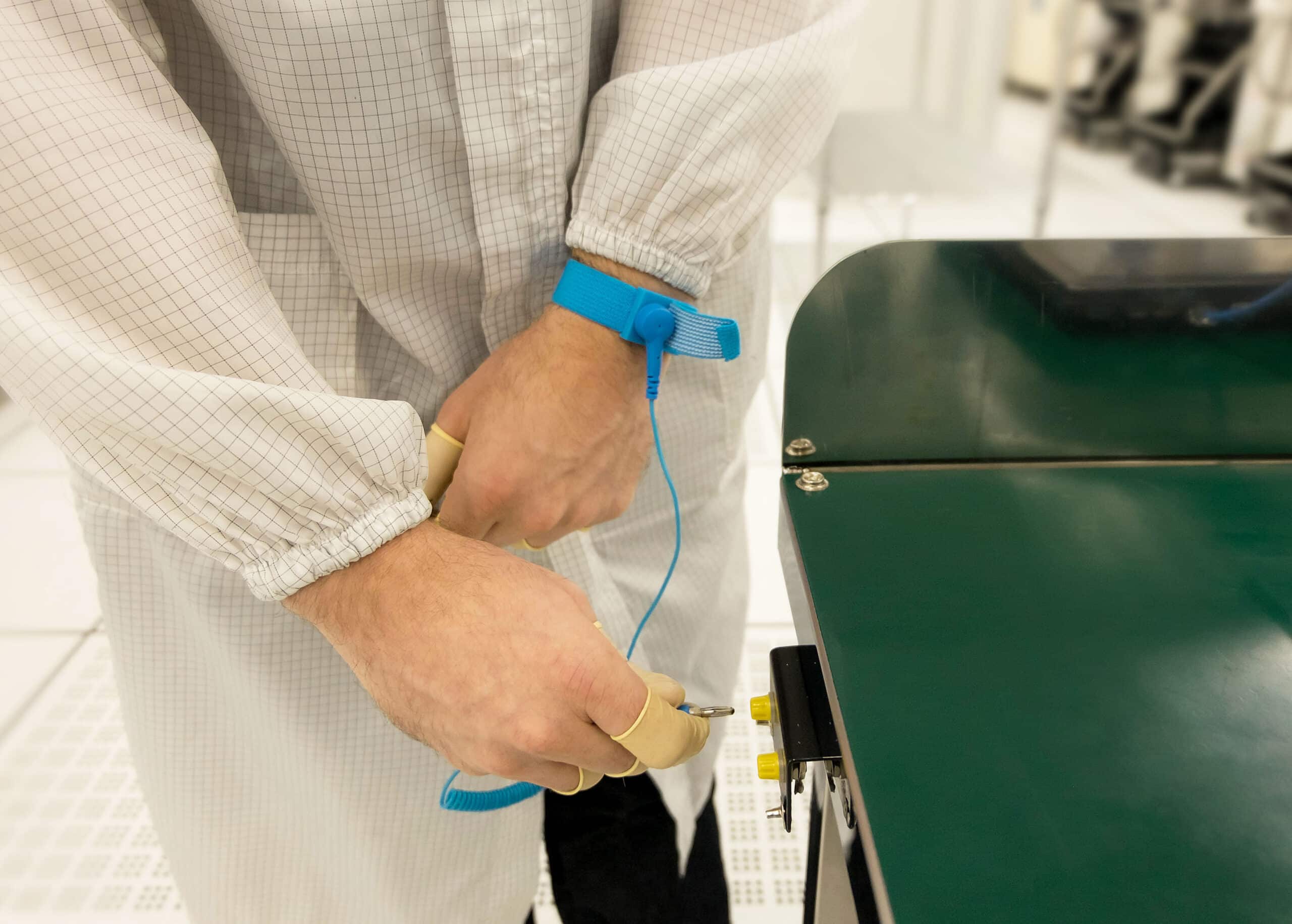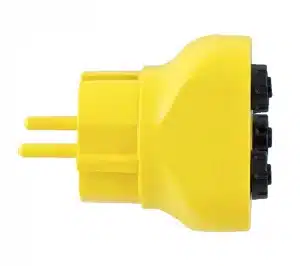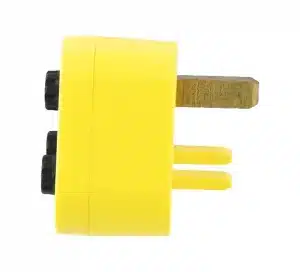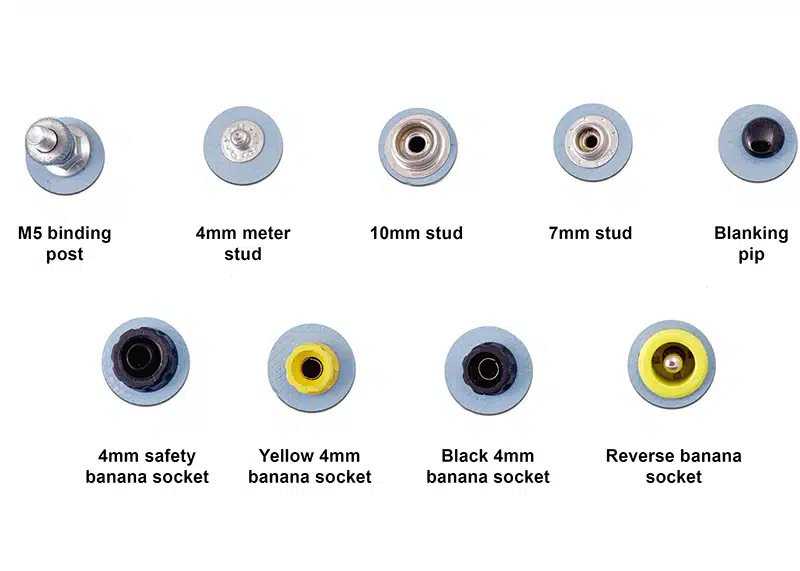Electrostatic discharge (ESD) grounding is simply the removal or reduction of electrostatic charge between two or more conductive bodies within an electric field, usually with the help of a third body called ESD ground. Sometimes known as ‘grounding plugs’, ESD bonding points play an important role in safeguarding against electrostatic discharge, protecting components or electronic devices during handling or assembly. When you’re creating or maintaining an ESD protected area (EPA), it’s vital to have effective ESD bonding points in places that are accessible.
Article Contents:
When working with components which are sensitive to static discharge, such as electrical items i.e. PCBs and ICs, various protective measures should be taken. Typically, this type of work is undertaken in an EPA, where static-minimising and mitigating steps can reduce the risk of static build-up and discharge.
To facilitate this, various protective equipment is used, such as ESD benches with static dissipative properties and ESD flooring or anti-static mats. However, it is ESD wrist straps and cords, along with ESD footwear and heel straps that are most commonly used as protective equipment.
ESD wrist straps and cords are worn when handling or working with any components which are sensitive to static discharge. These protective devices are worn because the human body can generate static charge, which could then damage sensitive components. By wearing an ESD wrist strap and cord, the operator is ‘grounded’ and the static charge is dissipated to Earth.
Each strap consists of a wrist band with a grounding cord attached to its snap. It is the grounding cord which mitigates the static charge, while the wrist strap ensures the cord remains in place, makes good contact with the skin, and provides additional comfort to the wearer.
ESD footwear and heel straps work in a similar way to ESD wrist bands and cords; they simply use a different type of product to achieve the same effect. When appropriate flooring is in place, ESD footwear can be used to ground the wearer and prevent static discharge. Similarly, heel straps can be added to an existing pair of shoes to facilitate grounding.
When operators are working in a large EPA or are regularly on their feet, wearing ESD footwear or heel straps can be a more convenient way to safeguard the worker and protect static-sensitive products. However, it is important to ensure appropriate flooring is in place if ESD footwear and heel straps are worn, as an insulated floor will prevent them from providing adequate protection.
Wearing ESD protective equipment, such as a wrist strap, isn’t sufficient to eliminate the risk of static discharge. Instead, the operator needs to ensure that the protective equipment (e.g., the wrist strap) provides a grounding path so that the electrostatic charge can be safely grounded.
An ESD bonding point does just that and makes it easy for operators to ground any electric charges that arise in an ESD protected area. One of the simplest methods to do this is by connecting a bonding point via a grounding socket.
Sometimes referred to as, ‘Earthing a socket’, an Earth bonded plug can be inserted into a regular plug socket. As it only connects to the Earth conductor, it is capable of providing for electrical charges to be grounded.
ESD protective equipment can then be attached to the ESD bonding point, so that any electrical charges travel down the line and are grounded by the Earth conductor. If an operator is wearing an ESD wrist strap, for example, they would attach one end of the grounding cord of the wrist strap to the ESD bonding point, which sits inside a regular plug socket. For best practice, it is recommended that the ground connections use firm fitting connecting devices such as metallic crimps, snaps and banana plugs to connect to designated ground points. If an electrical charge occurs, it will travel down the grounding cord and on to the bonding point, where the Earth conductor will ensure it is grounded.
It is important to note that there should only be one Earth facility connection in your EPA. However, there can be as many Earth bonding points as you require.

Socket grounding is a common and effective way to protect against static discharge. This can be achieved by inserting an ESD bonding point such as a plug or bracket into a mains Earth. Although a simple method, it is important to select the right bonding point for it to work correctly. Several factors you should consider are:
You’ll want to ensure that the bonding points you select have European plug sockets if you’re operating within the EU, for example, and a UK plug socket if you’re working within the United Kingdom.


In addition to this, you’ll need to make sure that the ESD bonding points you choose feature the right connectors for the type of ESD protective equipment you’re using.
A 10mm socket typically features a 10mm stud and 1 meg-ohm resistor as standard, which can be used with most ESD wrist straps, for example. Alternatively, you might need a 4mm banana socket if you’re using ESD protective equipment with this type of connector.
Often, you may require specific connectors or resistance values to match the type of equipment you are using. This can be achieved through customisation. Bondline can provide an array of customisation options for your bonding points, from the size of studs, types of banana sockets, resistance values and posts, to special printing, languages and logos. Typical configurations can include the following below.

Earth bonding plugs offer a simple method of grounding, providing a common ground point using protective Earth in an ESD protected area. They are widely utilised as they can be simply inserted into a mains supply socket anywhere in the EPA. As many operators work at dedicated ESD workbenches, having an Earth bonding plug nearby is always beneficial.
You will find that there are various types of connector points on the front of the bonding plugs. Depending on your requirements, the type of connectors should be chosen according to your needs. If operators routinely work with different types of ESD protective equipment, for example, you might want to choose Earth bonding plugs which feature 10mm studs, M5 posts and banana sockets. Most bonding plugs will have a 1 meg-ohm resistor as standard, although some may have a higher value resistor or no resistor at all. It is important to check what type of connectors and resistance values you need before selecting an Earth bonding plug.
Our range of Earth bonding plugs make it easy to provide a selection of connectors, regardless of how much space you have available. Moreover, they are made to the highest quality and standards as they are manufactured here in the UK.
Each of these bonding plugs are also available in EU plug format with the option to be customised.
As well as using Earth bonding plugs to facilitate grounding, it can be advantageous to have Earth bonding brackets available too. These work in the same way as an Earth bonding plug but can be affixed under a shelf or a workbench for easy access.
Earth bonding brackets work by distinguishing between Earth facility and Earth bonding point. The connection to Earth is made via the supplied 2m standard black wire fitted with a ring terminal. Typically, an Earth bonding bracket will incorporate 1 meg ohm resistors on each individual stud or socket connection.
Again, you can select Earth bonding brackets that feature a range of different connection options to ensure that various types of ESD protective equipment can rely on the bonding point to provide a grounding route.
Our range of Earth bonding brackets come in all sorts of connectors to meet various requirements. They are made to the highest standards as they are manufactured here in the UK. With the option of customisation, there are brackets that suit all.
For companies or organisations that require an EPA, having effective ESD protective equipment is essential. Whether you’re operating with a single ESD workbench, or you have an entire floor as a dedicated EPA, our bonding points and ESD protective equipment enable you to create and maintain a customised workspace that protects employees and keeps components safe from static discharge.
To learn more, explore our range of UK manufactured Earth bonding points now or get in touch with our helpful team at sales@bondline.co.uk.
Our Earth bonding points can be fully customised to match your requirements.
We can provide:
For specific configurations or special printing of Earth bonding points, please get in touch with us on +44 (0)1793 511000, sales@bondline.co.uk or fill in the form below.
Fields marked with an * are required
On selected products if ordered before 1pm
Dedicated account manager to help your ordering process
Great value on premium quality products
Bondline Electronics Ltd are a leading manufacturer and supplier of static control products within the ESD industry. Products such as Flexible and Rigid Packaging, Bench Matting, Wrist Straps, Heel Grounders and Shoes, ESD Protective Clothing and Gloves, Test and Measurement Equipment along with many storage and handling solutions.
Bondline products are all qualified and compliant according to IEC-61340-5-1 International Standard.
Registered Company Number: 02933918
Office Hours: Mon – Thurs: 9am – 5pm Fri: 9am – 2pm

Bondline Electronics Ltd are a leading manufacturer and supplier of static control products within the ESD industry. Products such as Flexible and Rigid Packaging, Bench Matting, Wrist Straps, Heel Grounders and Shoes, ESD Protective Clothing and Gloves, Test and Measurement Equipment along with many storage and handling solutions.
Some of these cookies are essential, while others help us to improve your experience by providing insights into how the site is being used.
For more information and to read more about our privacy policy, please visit our Privacy Policy
Necessary cookies enable core functionality. The website cannot function properly without these cookies, and can only be disabled by changing your browser preferences.